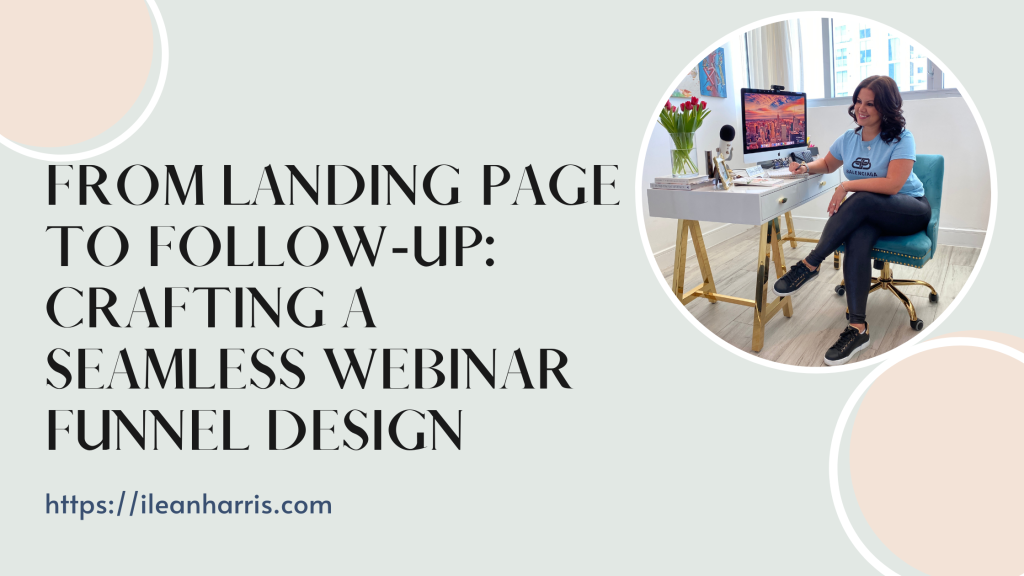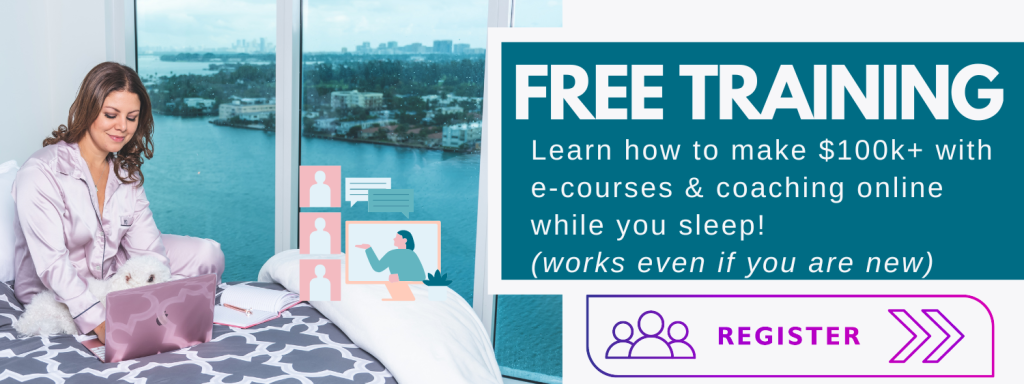
This post is all about webinar funnel design.
From Landing Page to Follow-Up: Crafting a Seamless Webinar Funnel Design
Webinars are an effective tool for generating leads, educating your audience, and ultimately driving sales.
However, simply hosting a webinar is not enough to guarantee success.
You also need to create a well-designed webinar funnel that guides your audience from the landing page to the follow-up sequence.
In this post, we’ll explore the key elements of webinar funnel design and how to create a seamless experience for your audience.
It’s worth it to learn! After working with clients in over 20 countries and having over 100,000 email subscribers, I have seen how powerful a webinar funnel is firsthand and how it can change your life!
 Why create a webinar funnel:
Why create a webinar funnel:
Webinar funnels are a powerful tool for building relationships with potential customers and driving sales for your business.
Here are some reasons why you should consider building a webinar funnel:
- Establish expertise and authority: Hosting a webinar allows you to share your knowledge and expertise on a particular topic, which can help establish you as an authority in your field. By providing valuable information and insights, you can build trust with your audience and position yourself as a thought leader in your industry. For instance, you probably don’t care that I have an MBA. But if I can help you solve a problem that is driving you nuts, that will get your attention and gain your trust.
- Generate leads: Webinars are an effective way to generate high-quality leads for your business. By requiring attendees to provide their contact information to register for the webinar, you can build a list of potential customers who are interested in your products or services.
- Nurture leads: Once you have generated leads through your webinar, you can use the follow-up sequence to nurture those leads and build a relationship with them over time. By providing additional value and insights through email, you can keep your brand top of mind and encourage potential customers to take action.
- Drive sales: Ultimately, the goal of a webinar funnel is to drive sales for your business. By providing value and building a relationship with your audience, you can increase the likelihood that they will make a purchase from your business. With a well-designed follow-up sequence and a compelling offer, you can turn leads into paying customers and grow your revenue.
In summary, building a webinar funnel can help you establish expertise and authority, generate leads, nurture leads, and drive sales for your business.
With the right webinar funnel design, you can create a powerful marketing tool that can help take your business to the next level.
Learn more about webinars here.
Let’s dive in:
Step 1: Define your target audience and webinar topic
Before you begin designing your webinar funnel, it’s important to define your target audience and webinar topic. Who is your ideal customer? What problems do they have that your product or service can solve? What are their goals and motivations? Understanding your target audience will help you create a webinar that is tailored to their needs and interests.
Next, choose a topic that is relevant to your audience and aligns with your business goals.
Your topic should be educational and informative, providing value to your audience while also highlighting the benefits of your product or service.
Step 2: Create a landing page that converts
The landing page is the first point of contact between your audience and your webinar funnel.
It’s important to create a landing page that is visually appealing, easy to navigate, and optimized for conversions.
Here are some key elements to include on your landing page:
- Headline: Your headline should be clear and attention-grabbing, highlighting the benefits of your webinar and enticing people to register.
- Benefits: List the key benefits of attending your webinar, such as the knowledge or skills participants will gain.
- Registration form: Keep your registration form simple, only asking for the essential information you need to follow up with your attendees.
- Social proof: Include testimonials or social proof from previous attendees to build trust and credibility.
- Countdown timer: A countdown timer can create a sense of urgency and encourage people to register before time runs out.
Learn more about a webinar sales funnel here.
Step 3: Design your webinar content
Your webinar content should be engaging, informative, and aligned with your target audience’s interests and needs.
Here are some tips for designing your webinar content:
- Create a compelling presentation: Use visuals, storytelling, and other techniques to keep your audience engaged and interested.
- Offer value: Provide valuable information and insights that attendees can’t get elsewhere.
- Use interactive features: Polls, quizzes, and Q&A sessions can keep your audience engaged and help you gather feedback.
- Highlight the benefits of your product or service: Use your webinar content to showcase the benefits of your product or service and demonstrate how it can solve your audience’s problems.
Step 4: Build your follow-up sequence
The follow-up sequence is a crucial part of your webinar funnel. It’s where you nurture your leads and guide them towards a purchase.
Here are some key elements to include in your follow-up sequence:
- Thank-you email: Send a thank-you email immediately after the webinar to show your appreciation and provide a recording of the webinar for those who couldn’t attend.
- Educational content: Follow up with educational content that expands on the webinar content and provides additional value to your audience.
- Offer: Include a limited-time offer that incentivizes attendees to purchase your product or service.
- Urgency: Use urgency to encourage attendees to take action, such as limited-time discounts or scarcity of the product.
Step 5: Optimize your webinar funnel design
Once your webinar funnel is up and running, it’s important to analyze and optimize your results.
Learn more about webinar funnels here.
Here are some key metrics to track:
- Conversion rate: Track the percentage of people who take action after attending your webinar.
- Attendance rate: Track the percentage of people who attend your webinar to see how engaging your content is.
- Registration rate: Track the percentage of people who register for your webinar to see how effective your marketing efforts are.
Use this data to optimize your webinar funnel design for maximum success.
Here are some tips for optimizing your webinar funnel design:
- Test your landing page: A/B test different versions of your landing page to see which design, copy, and images result in the highest conversion rates.
- Improve your webinar content: Gather feedback from attendees and adjust your webinar content to improve engagement and value.
- Analyze your follow-up sequence: Track the conversion rates of your follow-up sequence and adjust your messaging or offer to improve results.
- Refine your targeting: Use the data from your webinar funnel to refine your targeting and reach your ideal audience more effectively.
Conclusion
Creating a successful webinar funnel requires careful planning, design, and optimization.
By following these steps, you can create a seamless webinar funnel that guides your audience from the landing page to the follow-up sequence and ultimately drives sales for your business.
Remember to continually analyze and optimize your results to improve the effectiveness of your webinar funnel design over time.
With a well-designed webinar funnel, you can take your online business to the next level and achieve your business goals.
This post was all about webinar funnel design.











